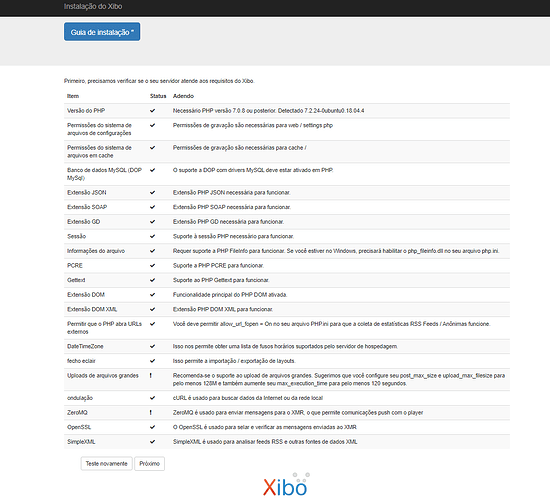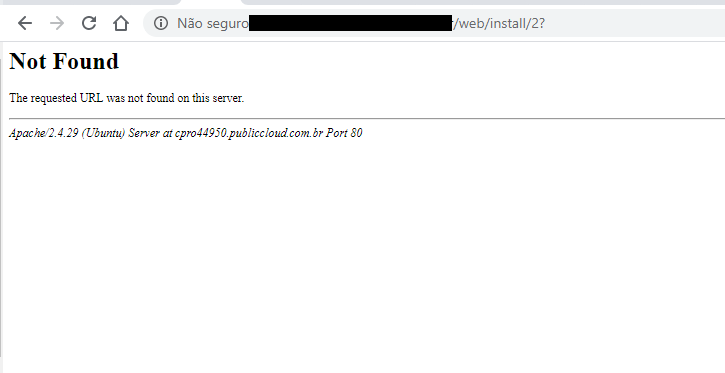Hello everyone! I can’t access the configuration page of the database. I arrive at the 1st installation page. When clikco and next falls on an error page
Can you post the following to help us troubleshoot:
- your Apache configuration for this website
- your Apache error log
Thank you
1–Server version: Apache/2.4.29 (Ubuntu)
Server built: 2020-03-13T12:26:16
2–erro
“”[Mon Apr 27 06:25:04.082106 2020] [mpm_prefork:notice] [pid 1228] AH00163: Apache/2.4.29 (Ubuntu) configured – resuming normal operations
[Mon Apr 27 06:25:04.082146 2020] [core:notice] [pid 1228] AH00094: Command line: ‘/usr/sbin/apache2’
[Mon Apr 27 12:16:36.361969 2020] [php7:error] [pid 19812] [client 95.213.177.124:59525] script ‘/var/www/html/xibo/azenv.php’ not found or unable to stat, referer: https://proxyradar.com/""
@Chaollyn
I need the configuration of the website on Apache, not the version in use.
This is usually located under /etc/apache2/sites-available and ends with a .conf
It should contain something like
<VirtualHost *:80>
ServerName example.com
ServerAlias www.example.com
ServerAdmin webmaster@example.com
DocumentRoot /var/www/example.com/public_html
<Directory /var/www/example.com/public_html>
Options -Indexes +FollowSymLinks
AllowOverride All
</Directory>
ErrorLog ${APACHE_LOG_DIR}/example.com-error.log
CustomLog ${APACHE_LOG_DIR}/example.com-access.log combined
</VirtualHost>
This is also something strange:
/var/www/html/xibo/azenv.php’ not found or unable to stat
so sorry
apache2.conf
# This is the main Apache server configuration file. It contains the
# configuration directives that give the server its instructions.
# See http://httpd.apache.org/docs/2.4/ for detailed information about
# the directives and /usr/share/doc/apache2/README.Debian about Debian specific
# hints.
#
#
# Summary of how the Apache 2 configuration works in Debian:
# The Apache 2 web server configuration in Debian is quite different to
# upstream’s suggested way to configure the web server. This is because Debian’s
# default Apache2 installation attempts to make adding and removing modules,
# virtual hosts, and extra configuration directives as flexible as possible, in
# order to make automating the changes and administering the server as easy as
# possible.
# It is split into several files forming the configuration hierarchy outlined
# below, all located in the /etc/apache2/ directory:
#
# /etc/apache2/
# |-- apache2.conf
*# | -- ports.conf* *# |-- mods-enabled* *# | |-- *.load* *# | – .conf
# |-- conf-enabled
# | -- *.conf* *# – sites-enabled
*# `-- .conf
#
#
# * apache2.conf is the main configuration file (this file). It puts the pieces
# together by including all remaining configuration files when starting up the
# web server.
#
# * ports.conf is always included from the main configuration file. It is
# supposed to determine listening ports for incoming connections which can be
# customized anytime.
#
# * Configuration files in the mods-enabled/, conf-enabled/ and sites-enabled/
# directories contain particular configuration snippets which manage modules,
# global configuration fragments, or virtual host configurations,
# respectively.
#
# They are activated by symlinking available configuration files from their
*# respective -available/ counterparts. These should be managed by using our
# helpers a2enmod/a2dismod, a2ensite/a2dissite and a2enconf/a2disconf. See
# their respective man pages for detailed information.
#
# * The binary is called apache2. Due to the use of environment variables, in
# the default configuration, apache2 needs to be started/stopped with
# /etc/init.d/apache2 or apache2ctl. Calling /usr/bin/apache2 directly will not
# work with the default configuration.
# Global configuration
#
#
# ServerRoot: The top of the directory tree under which the server’s
# configuration, error, and log files are kept.
#
# NOTE! If you intend to place this on an NFS (or otherwise network)
# mounted filesystem then please read the Mutex documentation (available
# at URL:http://httpd.apache.org/docs/2.4/mod/core.html#mutex);
# you will save yourself a lot of trouble.
#
# Do NOT add a slash at the end of the directory path.
#
#ServerRoot “/etc/apache2”
#
# The accept serialization lock file MUST BE STORED ON A LOCAL DISK.
#
#Mutex file:${APACHE_LOCK_DIR} default
#
# The directory where shm and other runtime files will be stored.
#
DefaultRuntimeDir ${APACHE_RUN_DIR}
#
# PidFile: The file in which the server should record its process
# identification number when it starts.
# This needs to be set in /etc/apache2/envvars
#
PidFile ${APACHE_PID_FILE}
#
# Timeout: The number of seconds before receives and sends time out.
#
Timeout 300
#
# KeepAlive: Whether or not to allow persistent connections (more than
# one request per connection). Set to “Off” to deactivate.
#
KeepAlive On
#
# MaxKeepAliveRequests: The maximum number of requests to allow
# during a persistent connection. Set to 0 to allow an unlimited amount.
# We recommend you leave this number high, for maximum performance.
#
MaxKeepAliveRequests 100
#
# KeepAliveTimeout: Number of seconds to wait for the next request from the
# same client on the same connection.
#
KeepAliveTimeout 5
# These need to be set in /etc/apache2/envvars
User ${APACHE_RUN_USER}
Group ${APACHE_RUN_GROUP}
#
# HostnameLookups: Log the names of clients or just their IP addresses
# e.g., www.apache.org (on) or 204.62.129.132 (off).
# The default is off because it’d be overall better for the net if people
# had to knowingly turn this feature on, since enabling it means that
# each client request will result in AT LEAST one lookup request to the
# nameserver.
#
HostnameLookups Off
# ErrorLog: The location of the error log file.
# If you do not specify an ErrorLog directive within a
# container, error messages relating to that virtual host will be
# logged here. If you do define an error logfile for a
# container, that host’s errors will be logged there and not here.
#
ErrorLog ${APACHE_LOG_DIR}/error.log
#
# LogLevel: Control the severity of messages logged to the error_log.
# Available values: trace8, …, trace1, debug, info, notice, warn,
# error, crit, alert, emerg.
# It is also possible to configure the log level for particular modules, e.g.
# “LogLevel info ssl:warn”
#
LogLevel warn
# Include module configuration:
IncludeOptional mods-enabled/.load*
IncludeOptional mods-enabled/.conf*
# Include list of ports to listen on
Include ports.conf
# Sets the default security model of the Apache2 HTTPD server. It does
# not allow access to the root filesystem outside of /usr/share and /var/www.
# The former is used by web applications packaged in Debian,
# the latter may be used for local directories served by the web server. If
# your system is serving content from a sub-directory in /srv you must allow
# access here, or in any related virtual host.
- Options FollowSymLinks*
- AllowOverride None*
- Require all denied*
<Directory /usr/share>
- AllowOverride None*
- Require all granted*
<Directory /var/www/>
- Options Indexes FollowSymLinks*
- AllowOverride None*
- Require all granted*
#<Directory /srv/>
# Options Indexes FollowSymLinks
# AllowOverride None
# Require all granted
#
# AccessFileName: The name of the file to look for in each directory
# for additional configuration directives. See also the AllowOverride
# directive.
#
AccessFileName .htaccess
#
# The following lines prevent .htaccess and .htpasswd files from being
# viewed by Web clients.
#
<FilesMatch “^.ht”>
- Require all denied*
#
# The following directives define some format nicknames for use with
# a CustomLog directive.
#
# These deviate from the Common Log Format definitions in that they use %O
# (the actual bytes sent including headers) instead of %b (the size of the
# requested file), because the latter makes it impossible to detect partial
# requests.
#
# Note that the use of %{X-Forwarded-For}i instead of %h is not recommended.
# Use mod_remoteip instead.
#
LogFormat “%v:%p %h %l %u %t “%r” %>s %O “%{Referer}i” “%{User-Agent}i”” vhost_combined
LogFormat “%h %l %u %t “%r” %>s %O “%{Referer}i” “%{User-Agent}i”” combined
LogFormat “%h %l %u %t “%r” %>s %O” common
LogFormat “%{Referer}i -> %U” referer
LogFormat “%{User-agent}i” agent
# Include of directories ignores editors’ and dpkg’s backup files,
# see README.Debian for details.
# Include generic snippets of statements
IncludeOptional conf-enabled/.conf*
# Include the virtual host configurations:
IncludeOptional sites-enabled/.conf*
# vim: syntax=apache ts=4 sw=4 sts=4 sr noet
This is the main configuration of apache2.
What is under sites-available? Has it been adapted for xibo?
<VirtualHost *:80>
ServerName http://my web server.com
ServerAdmin webmaster@localhost
DocumentRoot /var/www/html/xibo
# Available loglevels: trace8, ..., trace1, debug, info, notice, warn,
# error, crit, alert, emerg.
# It is also possible to configure the loglevel for particular
# modules, e.g.
#LogLevel info ssl:warn
ErrorLog ${APACHE_LOG_DIR}/error.log
CustomLog ${APACHE_LOG_DIR}/access.log combined
# For most configuration files from conf-available/, which are
# enabled or disabled at a global level, it is possible to
# include a line for only one particular virtual host. For example the
# following line enables the CGI configuration for this host only
# after it has been globally disabled with "a2disconf".
#Include conf-available/serve-cgi-bin.conf
vim: syntax=apache ts=4 sw=4 sts=4 sr noet
was following an installation of this link
The installation on youtube is not actual anymore - at least not for 2.3.3.
Please use the instructions provided here:
https://xibo.org.uk/docs/setup/prepare-your-environment
and
https://xibo.org.uk/docs/setup/xibo-on-a-web-server
In particular adapt the apache config under sites-available to:
<VirtualHost *:80>
DocumentRoot "/var/www/html/web"
ServerName <YourFQDN>
# Other directives here
AllowOverride All
Options Indexes FollowSymLinks MultiViews
Order allow,deny
Allow from all
Require all granted
</VirtualHost>
Notice that the DocumentRoot should end with /web
At the end restart apache with:
systemctl restart apache2
Please let me know if this works for you.
Hello
I managed to pass the database configuration page so that now there is an error creating a new database or proceed with an already created one
erro
Could not connect to MySQL with the administrator details. Please check and try again. Error Message = [SQLSTATE[HY000] [2002] php_network_getaddresses: getaddrinfo failed: Temporary failure in name resolution]
Can you share with us how you managed to solve the first issue? With the solution I described?
For the MySQL, please use the IP address of the SQL server or localhost if on the same host. Your host is not able to resolve the address of the SQL server, maybe no DNS server setup?
redid the entire installation, follow carefully to perform a step to the xibo manual worked.
until you get this page as a mysql error
already managed to solve the install and put to wheel was just a matter of permission inside the server
Thank you
This topic was automatically closed 91 days after the last reply. New replies are no longer allowed.

